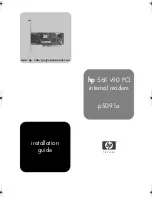
8 FAX
To receive these satellites, it is recommended that a special receiver is used with an IF
bandwidth of approx. 30-50 kHz. For the 1.7 GHz band, a small dish or Yagi-antenna
with a low noise LNA or LNC will also be required.
Meteosat 5 for example, transmits almost continuous IR and VIS pictures with a
resolution of 2.5 to 5 km in a format of 800 x 800 pixels. JVFAX and other programs are
able to automatically sense the beginning of each picture by using additional digital
information, and to make very impressive weather films. These films are interesting not
only for amateur meteorologists, but also for sailors, mountain climbers etc.
The pixel-rate from Meteosat 5 is 3360 pixels per second - 4 lines are transmitted per
second. The resulting bandwidth (relating to the appropriate Nyquist filtering) is
±
1680
Hz or a total of 3360 Hz. The PTC-IIex allows the maximum possible resolution of the
Meteosat signal to be displayed.
8.2.2
FM-FAX
Frequency modulated FAX is the established standard for weather maps and press
photographs on shortwave and longwave. This very old
WEFAX-Standard
is however
rapidly losing importance in the commercial sector. One reason is that the quality of the
FAX image is strongly influenced by the effective signal to noise ratio and the
propagation conditions (e.g. multipath propagation). In amateur use however, FM-FAX
is a useful mode as it allows high definition in comparison to SSTV, for transmission of
highly detailed pictures on good to very good HF paths.
The center frequency for FM-FAX has established itself as 1900 Hz. On longwave, a
frequency shift of 150 Hz is usual. On shortwave it has standardized at 400 Hz. This
means that in a normal FAX signal on shortwave, the brightness information
white
is
transmitted by a tone of 1900 + 400 Hz i.e. 2300 Hz, and "black" is represented by 1900...
400 Hz or 1500 Hz. A gray-scale is given by the appropriate frequencies between the
limits represented by 1500 and 2300 Hz.
The Nyquist bandwidth associated with FM-FAX is approximated by the formula
pix 2*shift. With a pixelrate of 1600/sec, one calculates a Nyquist bandwidth of
800+400+400+800 = 2400 Hz. The PTC-IIex allows a resolution of up to 2600
pixels/sec. The bandwidth of such a signal is approximately 3400 Hz, so that a steep sided
2.4 kHz SSB filter would be too narrow to allow the full resolution to be used. It is only
useful to increase the receiver bandwidth above 2.4 kHz when it is known that the
transmitted bandwidth is not limited to 2.4 kHz. Here only trial and error will tell if the
received picture resolution is improved with a wider receiver IF bandwidth.
The majority of FM-FAX transmissions are carried out with a speed of 120 lines per
minute, however 90 and 60 lines are also used by various agencies for special purposes.
The speed may be guessed, with a bit of practice, from the sound of the signal from the
station loudspeaker. If one is not sure, then it can be found by counting (for example for
half a minute) the typical rhythmical beat of the FAX transmission.
The start and end of an FM-FAX transmission is usually signaled by a long (several
seconds) tone sequence. This method is called APT, which means nothing more than
Automatic Picture Transmission.
JVFAX
and other FAX-Programs can evaluate these
APT tones automatically.
FM-FAX signals may be found all over the shortwave bands, and are easily recognized
by their typical rhythmical and somewhat
rough
tone. The receiver should be set to USB
96
Содержание PTC-IIex
Страница 14: ...List of Figures and Tables XII...
Страница 30: ...3 Installation 16...
Страница 108: ...7 Audio 94...
Страница 126: ...8 FAX 112...
Страница 173: ...12 SYStest 159...
Страница 183: ...14 Circuit Description 169...
Страница 195: ...15 Basics 181...
Страница 201: ...B Technical Data 187...
Страница 202: ...C Layout Appendix C 19 Layout B 1 Motherboard Figure B 1 Motherboard 188...
Страница 203: ...C Layout 189...
Страница 215: ...Index 202...
















































